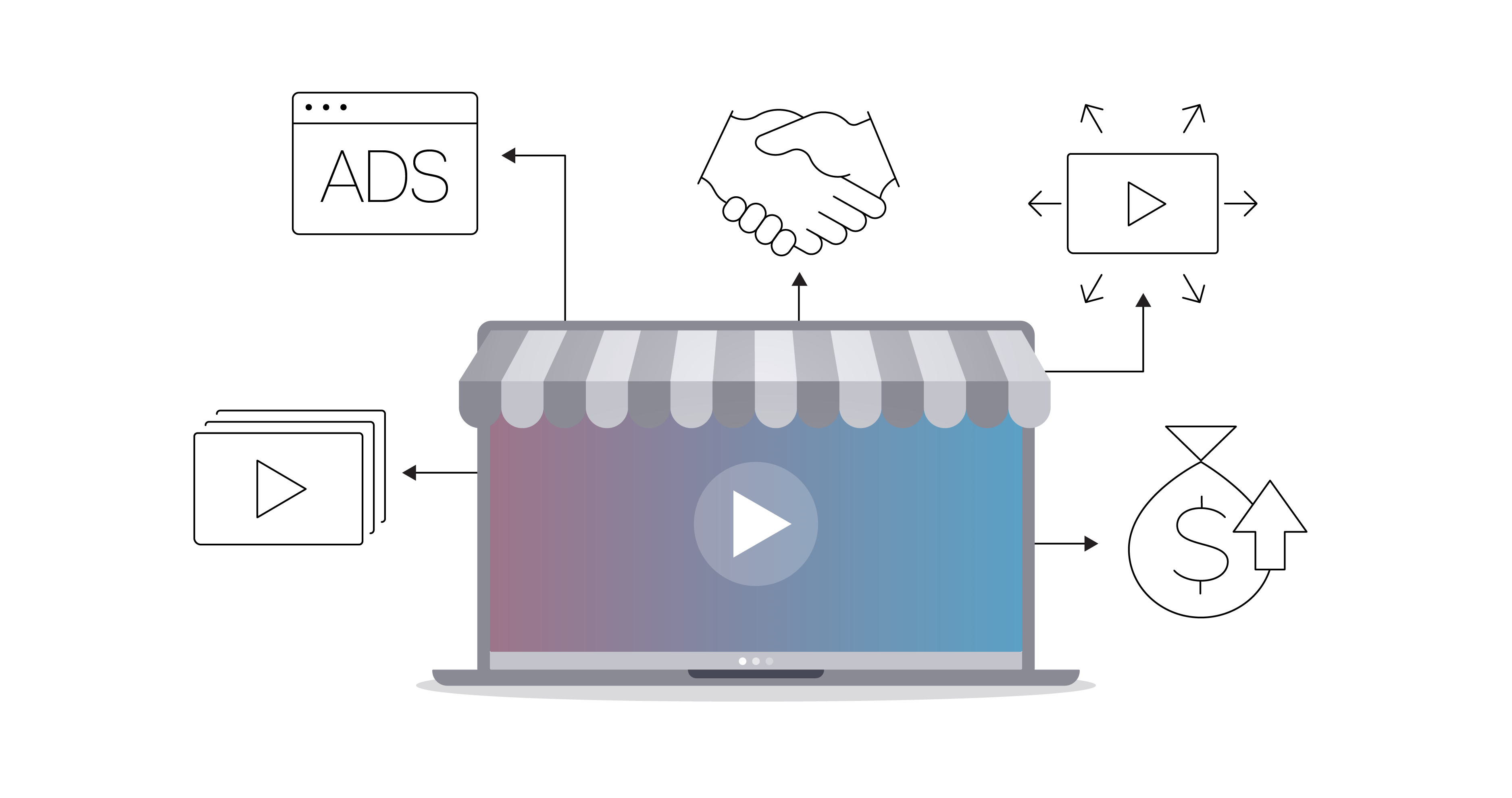The opportunity to monetize with an AVOD model has never been greater. In 2022 alone, the growth of AVOD viewers was higher than subscription OTT and free premium video streaming combined (Insider Intelligence). Furthermore, traditional pay TV is steadily declining and expected to account for roughly a third of households by 2027.
Yet, anyone who’s spent time in the media industry knows that implementing an AVOD service is easier said than done. In fact, Caretta Research described this process as “fiendishly complicated,” noting that many companies simply ignore this route altogether.
While AVOD can, indeed, be challenging, there’s another option for media companies who want a low-risk entry point: video ad marketplaces.
WHAT IS A VIDEO AD MARKETPLACE?
In its simplest form, a video ad marketplace is an online advertising platform that allows advertisers to buy video ads and publishers to monetize content.
For advertisers, ad marketplaces provide an efficient way to reach their target audience through placements alongside high quality content. For publishers, they provide a convenient way to sell inventory (in-stream ads within their videos) to advertisers. For both, ad marketplaces serve as an intermediary, using a single platform to manage, optimize, and facilitate programmatic video ads.
Publishers generate revenue through a programmatic advertising system, which eliminates the time-consuming process of finding individual advertisers and includes features like real-time bidding and unified auctions. Most leading ad services now have integrated supply-side platforms (SSPs), giving publishers the opportunity to quickly set up and control their revenue streams. By tracking and analyzing users, web traffic, costs, and reporting metrics like CPM (cost per thousand impressions), publishers can optimize their approach to maximize potential earnings.
There are three key elements to ad monetization solutions.
- Ad marketplace. The ad marketplace matches buyer and seller preferences via SSPs and DSPs (demand-side platforms) to deliver meaningful impressions for all parties.
- Ad server. The ad server distributes the ads, facilitates the management of the campaigns, and tracks performance. For advertisers, it offers tools and analytics to help manage and optimize the campaign. This includes quantitative data (video views, clicks, and impressions) as well as qualitative data (information about the audiences engaging with the ads). For publishers, it instantaneously determines which ads to serve with which video, and delivers that ad as a seamless part of the experience.
- Video player. A high quality player allows publishers to offer a variety of video ad strategies, including floating players, picture-in-picture ads, and header bidding.
WHAT ARE THE BENEFITS FOR PUBLISHERS?
One of the key benefits for publishers on video ad marketplaces is the stable and reliable income they can generate. They offer a fixed payment per click, view, or impression whether or not the ad directly contributes to a sale. This can take a lot of the guesswork out of how much the publisher will be paid. For many publishers, it’s simply a matter of creating great content and leveraging the marketplace’s ability to acquire advertisers that want to fill vacant advertising spots with relevant, high-quality ads.
Ad marketplaces can also offset the cost of producing content with the revenue generated from offering advertising opportunities. By opening up these additional streams of revenue, content creators can focus more on creating compelling content and less on finding and negotiating with advertisers.
Finally, ad marketplaces give creators peace of mind knowing they are getting the best possible rate for their ads through the automated bidding system. Advertisers tend to prefer this approach as well. According to eMarketer, more than 82% of digital video ad spending is transacted programmatically in the UK, Canada, U.S., Germany, and France. Ad marketplaces assure them that they’re paying the best available market price while getting a high-quality ad delivered on a premium video player to highly targeted audiences.
HOW DO YOU KNOW IF YOU’RE READY TO MONETIZE YOUR CONTENT?
Every video ad marketplace has different requirements for publishers, but they primarily involve two aspects of the publishers’ business.
- Content Library. Publishers must have an established content library. Advertisers expect their ads to reach the audiences they’re targeting, so having a well-curated library allows marketplaces to serve up ads on the most relevant content.
- Monthly Viewership. Publishers must also meet the demand for views and impressions. Beyond relevance, advertisers expect their ads to perform efficiently, reaching as much of the right audience as possible.
WHAT SHOULD YOU LOOK FOR IN A VIDEO AD MARKETPLACE?
Every publisher should also have requirements for video ad marketplaces. Features and options can vary dramatically, but the following examples from Brightcove’s Ad Monetization service illustrate what an industry-leading media platform prioritizes.
BIDDING OPTIONS
Unsold inventory is a common challenge for media companies, typically due to technical issues, pricing issues, or to avoid the same user seeing the same ad too many times. But as a publisher, your goal is to sell as much of your inventory as possible at the best rate possible. Ad servers do this by bidding out your inventory to advertisers in several different ways.
To maximize revenue, a good ad marketplace should include the following options.
- Fallback bidding. This approach allows bids to be made against unsold inventory, with the highest paying bidder winning that impression.
- Header or player bidding. This approach allows the player to conduct the auction and pass the winning bid back to your ad server without latency. The highest bidding marketplace will get the inventory, maximizing the revenue potential from your content.
AD INSERTION
Ad insertion is how your ads are inserted into the video stream through your video player. There are two primary methods for inserting ads.
- Server-Side Ad Insertion (SSAI). SSAI inserts ads directly into the content at the server end of the streaming delivery chain. It typically provides the best viewing experience, as the transitions between content and ads are much smoother with less buffering. The tradeoff is that SSAI tends to require more technical expertise to implement, and the overall ad experience isn’t very flexible. It’s also important to note that since SSAI is an integrated part of your content, this method ensures the ads are delivered instead of being blocked by ad blockers.
- Client-Side Ad Insertion (CSAI). CSAI inserts ads directly into the video player on the user’s device. It offers a more flexible ad experience, as ads can be personalized based on user data like browsing history and inserted at any point in the video. However, since playback is dependent on the user’s device and internet connection, it’s more susceptible to buffering and ad blockers. While the overall viewing experience may not be seamless, the ad experience can be enhanced with other options like the ability to skip, click, or close an ad.
AD EXPERIENCE
Selling ad inventory will only generate revenue if the ad experience is exceptional. This means your video ad marketplace needs to be able to serve ads to your video content regardless of what format it is.
For example, while most of your content may be video on demand (VOD) or over the top (OTT), you may still want to monetize a special live event you’re broadcasting. The key is having the flexibility so that you’re able to get the most out of your video content in any format.
Furthermore, your video player should offer viewability metrics, so you can track the effectiveness of your ad experience. Advertisers don’t just want impressions anymore; they expect publishers to prove that viewers are actually seeing the ads.
TAKING ADVANTAGE OF VIDEO ADVERTISING OPPORTUNITIES
Video ad marketplaces offer publishers a variety of ways to monetize their content in an increasingly competitive landscape. Understanding how video ad marketplaces work can help you reach your goals and position you to seize the opportunities this significant growth market offers.
With Brightcove, taking advantage of this opportunity has never been easier. Not only do we offer a full-service ad marketplace solution, we offer industry-leading ad metrics like ad sensitivity. Getting started with AVOD can be hard, but Brightcove Ad Monetization makes it easy to get the most revenue from your media.




